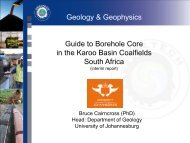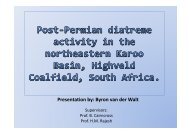coaltech upper olifants river catchment wetland inventory ...
coaltech upper olifants river catchment wetland inventory ...
coaltech upper olifants river catchment wetland inventory ...
Create successful ePaper yourself
Turn your PDF publications into a flip-book with our unique Google optimized e-Paper software.
3.6.9.3 Fauna<br />
A number of alien fish and invertebrate species occur in the <strong>wetland</strong>s of the UORC. These<br />
species can have a large impact on the indigenous fauna due to competition and pressure<br />
from natural enemies. Trout fishing is a mayor recreational activity in the area and trout are<br />
introduced to trout dams on a continuous basis. The trout often have a negative impact on<br />
the native fish populations, due to competition for resources. The introduction of trout into<br />
<strong>river</strong>s where they are absent at present is prohibited (Heath and Claassen 1999, Palmer et al<br />
2002).<br />
3.7 Indicators of <strong>wetland</strong> health<br />
3.7.1 National River Health Programme<br />
Although <strong>river</strong>s are not included as <strong>wetland</strong>s the health of the <strong>river</strong> system can reflect the<br />
health of the <strong>wetland</strong>s in the area. Healthy <strong>wetland</strong>s, especially healthy riparian <strong>wetland</strong>s,<br />
have a positive impact on the <strong>river</strong> health and degraded <strong>wetland</strong>s often have a negative<br />
impact on the <strong>river</strong> health.<br />
The National River Health Programme is a programme that assesses the health of a <strong>river</strong><br />
system. The health of the <strong>river</strong> systems are published in reports and are available to the<br />
public (CSIR 2001, http://www.csir.co.za/rhp/index.html). An assessment of the Crocodile,<br />
Sabie-Sand and Olifants River Systems has been conducted as part of this programme.<br />
The UORC is divided into ecoregions, representing distinct units within the <strong>catchment</strong>. The<br />
ecoregions of the Olifants River <strong>catchment</strong> relevant to this project are 2.08, 2.09, 7.02, 7.03,<br />
7.04 and 7.05 (Figure 4). Ecoregions 7.02, 7.03 and 7.04 are located in the grasslands of the<br />
escarpment plateau, with some rolling rocky areas interspersed. The Wilge,<br />
Bronkhorstspruit, Klein Olifants and Olifants Rivers originate in these ecoregions. Ecoregions<br />
2.08 and 2.09 are located on the Highveld Plateau and descend the Drakensberg<br />
Escarpment. The confluences of the Olifants and the Klein Olifants Rivers, as well as the<br />
confluence between the Olifants River and the Wilge River are included in these ecoregions<br />
(CSIR 2001).<br />
Tools used to assess the health of the <strong>river</strong>s are:<br />
o South African Scoring System (SASS) 5;<br />
Wetland Database for UORC - 54 -




